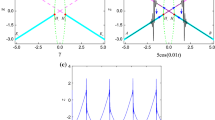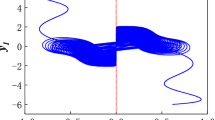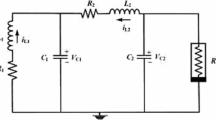Abstract
Non-smooth factors and multiscale couplings are commonly present in daily life and engineering applications. In this research paper, our focus lies in exploring the mechanism behind bursting oscillations and the intricate dynamical properties resulting from diverse scale couplings within the frequency domain of Filippov systems. Based on an improved Sprott C model, we provide equilibrium branches and bifurcations of subsystems in different regions for two typical parameter cases. The transformed phase portrait exhibits the presence of asymmetric bursting attractors. By superimposing the transformed phase portrait with the equilibrium branches and bifurcation diagram, we can uncover the underlying generation mechanism of two distinct bursting modes. Our findings indicate that both equilibrium branches and bifurcations have a significant impact not only on the structure of bursting oscillation attractors but also on the configuration of quiescent states or spiking states, as well as the transition mechanism between these states. As a result, various bursting modes can emerge due to these factors. In this system, as a result of the presence of the slow passage effect, when the trajectory traverses the stable equilibrium branch towards the bifurcation point, it does not immediately enter into oscillatory behavior. Instead, it continues along the unstable branch for a certain duration before eventually transitioning into oscillations. Moreover, we can observe sliding behavior along the non-smooth interface. It is worth noting that, unlike most Filippov systems, the sliding behavior of this system is not caused by the sliding region on the boundary, but rather because of the attraction by the stable equilibrium branch. Our research results enrich the study of the complex dynamical behavior of high-dimensional non-smooth systems under different scales of coupling and deepen the understanding of the sliding behavior of Filippov systems on the boundary.





Similar content being viewed by others
Data availability
Data sharing not applicable to this article as no datasets were generated or analysed during the current study.
References
K.C.B. Benedetti, P.B. Gonçalves, S. Lenci, G. Rega, An operator methodology for the global dynamic analysis of stochastic nonlinear systems. Theor. Appl. Mech. Lett. 13(3), 100419 (2023)
I. Ahmad, M. Rahaman, Solvability of the system of extended nonlinear mixed variational-like inequalities and proximal dynamical system. J. Math. 2023, e7414514 (2023)
F. Yu, S. Xu, X. Xiao, W. Yao, Y. Huang, S. Cai, B. Yin, Y. Li, Dynamics analysis, FPGA realization and image encryption application of a 5D memristive exponential hyperchaotic system. Integration 90, 58–70 (2023)
Q. Xu, X. Chen, B. Chen, H. Wu, Z. Li, H. Bao, Dynamical analysis of an improved FitzHugh-Nagumo neuron model with multiplier-free implementation. Nonlinear Dyn. 111(9), 8737–8749 (2023)
X. Gao, J. Mou, S. Banerjee, Y. Zhang, Color-gray multi-image hybrid compression-encryption scheme based on BP neural network and knight tour. IEEE Trans. Cybern. 53, 5037 (2023)
X. Liu, J. Mou, Y. Zhang, Y. Cao, A new hyperchaotic map based on discrete memristor and meminductor: dynamics analysis, encryption application, and DSP implementation. IEEE Trans. Ind. Electr. (2023). https://doi.org/10.1109/TIE.2023.3281687
Q. Guo, H. Liu, Y. Wang, J. Li, M. Zhao, P.K. Tiwari, Z. Jin, C. Dai, Dynamics of a stochastic nutrient-plankton model with impulsive control strategy. Eur. Phys. J. Plus 138(5), 470 (2023)
R. Lima, R. Sampaio, Random stick-slip oscillations in a multiphysics system. Eur. Phys. J. Plus 136(8), 879 (2021)
Z. Zhang, Q. Bi, Bifurcation in a piecewise linear circuit with switching boundaries. Int. J. Bifurcation Chaos 22(02), 1250034 (2012)
A. Dubey, K. Gustavsson, G.P. Bewley, B. Mehlig, Bifurcations in droplet collisions. Phys. Rev. Fluids 7(6), 064401 (2022)
N. Hima, F. D’Annibale, F. Dal Corso, Non-smooth dynamics of buckling based metainterfaces: rocking-like motion and bifurcations. Int. J. Mech. Sci. 242, 108005 (2023)
M.M. Henao, R. Cristiano, D.J. Pagano, Bifurcation analysis of 3D-PWS systems with two transversal switching boundaries: A case study in power electronics. Phys. D 442, 133505 (2022)
L. Pei, A.S.E. Chong, E. Pavlovskaia, M. Wiercigroch, Computation of periodic orbits for piecewise linear oscillator by Harmonic Balance Methods. Commun. Nonlinear Sci. Numer. Simul. 108, 106220 (2022)
K.S. Morupisi, C. Budd, An analysis of the periodically forced PP04 climate model, using the theory of non-smooth dynamical systems. IMA J. Appl. Math. 86(1), 76–120 (2021)
A. Al-khedhairi, Dynamical analysis and chaos synchronization of a fractional-order novel financial model based on Caputo-Fabrizio derivative. Eur. Phys. J. Plus 134(10), 532 (2019)
C. Xing, Z. Zhang, M. Peng, Bifurcation structures and bursting dynamics in a two degrees of freedom quasi-zero stiffness system with elastic constrain. Chaos Solitons Fractals 161, 112324 (2022)
Z. Rui, F. Min, L. Lu, B. Ye, On the Coexistence (Switching Bifurcation and FPGA Implementation for a Non-smooth Rayleigh-Duffing-like System. Preprint, In Review, 2022)
R. Tian, Y. Zhou, Q. Wang, L. Zhang, Bifurcation and chaotic threshold of duffing system with jump discontinuities. Eur. Phys. J. Plus 131(1), 15 (2016)
M.E. Semenov, S.V. Borzunov, P.A. Meleshenko, A new way to compute the Lyapunov characteristic exponents for non-smooth and discontinues dynamical systems. Nonlinear Dyn. 109(3), 1805–1821 (2022)
B. Namorado, A. Pinto da Costa, F.M.F. Simões, Modelling rotational friction damping devices using the non-smooth dynamics method. Eng. Struct. 259, 114118 (2022)
J. Llibre, D.D. Novaes, M.A. Teixeira, On the birth of limit cycles for non-smooth dynamical systems. Bull. Sci. Math. 139(3), 229–244 (2015)
C.A. Buzzi, A.L. Rodero, M.A. Teixeira, Stability conditions for refractive partially integrable piecewise smooth vector fields. Phys. D 440, 133462 (2022)
A.A. Antunes, T. Carvalho, R. Varão, On topological entropy of piecewise smooth vector fields. J. Differ. Equ. 362, 52–73 (2023)
R. Bertram, J.E. Rubin, Multi-timescale systems and fast-slow analysis. Math. Biosci. 287, 105–121 (2017)
A.L. Hodgkin, A.F. Huxley, Currents carried by sodium and potassium ions through the membrane of the giant axon of Loligo. J. Physiol. 116(4), 449–472 (1952)
A.L. Hodgkin, A.F. Huxley, The components of membrane conductance in the giant axon of Loligo. J. Physiol. 116(4), 473–496 (1952)
A.L. Hodgkin, A.F. Huxley, The dual effect of membrane potential on sodium conductance in the giant axon of Loligo. J. Physiol. 116(4), 497–506 (1952)
X.J. Wang, J. Rinzel, Spindle rhythmicity in the reticularis thalami nucleus: synchronization among mutually inhibitory neurons. Neuroscience 53(4), 899–904 (1993)
S.M. Baert, J. Rinzel, H. Carrillo, Analysis of an autonomous phase model for neuronal parabolic bursting. J. Math. Biol. 33(3), 309–333 (1995)
J.C. Sprott, Some simple chaotic flows. Phys. Rev. E 50(2), R647–R650 (1994)
Z. Wei, Q. Yang, Dynamical analysis of the generalized Sprott C system with only two stable equilibria. Nonlinear Dyn. 68(4), 543–554 (2012)
O.S. Ojoniyi, A.N. Njah, A 5D hyperchaotic Sprott B system with coexisting hidden attractors. Chaos Solitons Fractals 87, 172–181 (2016)
M. Messias, A.C. Reinol, On the formation of hidden chaotic attractors and nested invariant tori in the Sprott A system. Nonlinear Dyn. 88(2), 807–821 (2017)
M. Messias, A.C. Reinol, On the existence of periodic orbits and KAM tori in the Sprott A system: a special case of the Nosé-Hoover oscillator. Nonlinear Dyn. 92(3), 1287–1297 (2018)
R. Ramamoorthy, K. Rajagopal, G.D. Leutcho, O. Krejcar, H. Namazi, I. Hussain, Multistable dynamics and control of a new 4D memristive chaotic Sprott B system. Chaos Solitons Fractals 156, 111834 (2022)
H. Yu, S. Du, E. Dong, J. Tong, Transient behaviors and equilibria-analysis-based boundary crisis analysis in a smooth 4D dynamical system. Chaos Solitons Fractals 160, 112220 (2022)
J. Morris, The Routh and Routh-Hurwitz stability criteria: their derivation by a novel method using comparatively elementary algebra. Aircr. Eng. Aerosp. Technol. 34(1), 25–27 (1962)
R.T. Rockafellar, Generalized directional derivatives and subgradients of nonconvex functions. Can. J. Math. 32(2), 257–280 (1980)
K. Yano, The Theory of Lie Derivatives and Its Applications (Courier Dover Publications, Amsterdam, 2020)
S.M. Baer, T. Erneux, J. Rinzel, The slow passage through a Hopf Bifurcation: delay, memory effects, and resonance. SIAM J. Appl. Math. 49(1), 55–71 (1989)
Acknowledgements
The authors are thankful to editors and referees for the careful reading and valuable suggestions that improve the quality and description of this manuscript. This work was supported by National Natural Science Foundation of China (No. 11872189), National Natural Science foundation of China (Grant No. 12102148) and Natural Science Research of Jiangsu Higher Education Institutions of China (Grant No. 21KJB110010).
Author information
Authors and Affiliations
Contributions
All authors contributed equally to the preparation of the whole manuscript.
Corresponding author
Ethics declarations
Conflict of interest
The authors have no competing interests to declare that are relevant to the content of this article.
Rights and permissions
Springer Nature or its licensor (e.g. a society or other partner) holds exclusive rights to this article under a publishing agreement with the author(s) or other rightsholder(s); author self-archiving of the accepted manuscript version of this article is solely governed by the terms of such publishing agreement and applicable law.
About this article
Cite this article
Zuo, W., Zhang, Z. & Peng, M. Bursting oscillations and bifurcation mechanisms in a 4D non-smooth Sprott C model. Eur. Phys. J. Plus 138, 659 (2023). https://doi.org/10.1140/epjp/s13360-023-04296-4
Received:
Accepted:
Published:
DOI: https://doi.org/10.1140/epjp/s13360-023-04296-4




